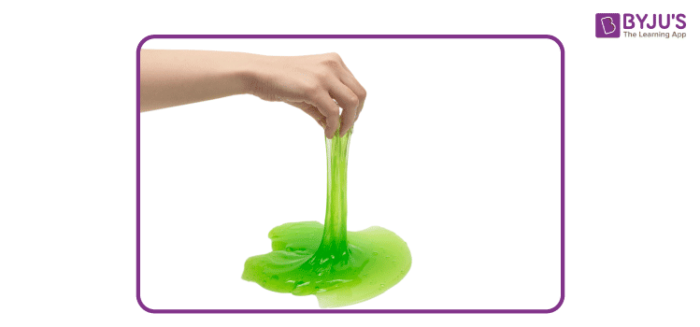Slime is a non-Newtonian fluid that is dilatant, which means when under stress, the material dilates or expands. Some other well-known stress-thickening materials are wet sand on the beach, starch solutions, some printer’s inks, silly putty, and quicksand.

Materials Required
- Borax powder (not boric acid)
- 100 ml glue (like Elmer’s white or gel glue)
- Food colouring
- Water
- Medium-sized bowl
- Small bowl or cup
- Measuring cups
- Spatula
Precaution
It is important to wash your hands before and after playing with the slime. Please do not eat the slime or let anyone else eat it. Be careful to only set your slime down on surfaces that won’t absorb the food colouring you added.
Procedure 1
Step 1: Mix 1 teaspoon (5 ml) of Borax powder into 1 cup of water (250 ml), creating a Borax solution and set to the side.
Step 2: Empty100.ml of glue into a bowl and mix in approximately 100 ml or ½ a cup of water (~125 ml), creating a diluted glue mixture. You could also refill the glue container to add the water.
Step 3: Put 1-2 drops of food colouring into this mixture, unless you want your slime to be colourless. (It is always a good idea to keep the coloured slime away from colour absorbing surfaces)
Step 4: Take the diluted glue mixture and slowly add the borax solution. You can observe the change in consistency taking place.
Your slime is polymerising! Keep mixing! You can now pick up the slime mix and knead it with your hands.
The more you play with the slime, the less sticky it will become.
Clean up! Store your slime in a zipper-lock bag. Toss it out when it begins to look funky.
What you Learn
This experiment stresses the importance of not mixing chemicals, even if you think it might be safe or you’ve seen your parents do it before. In this case, two liquid solutions blended to create an unfamiliar solid.
Procedure 2 – How to make super slime
Step 1: Pour half a cup of the polyvinyl alcohol solution into a beaker. If you want coloured slime, you can add food colouring to the PVA solution. Stir it well.
Step 2: Now slowly add two teaspoons of Borax solution into the PVA containing beaker. Stir it gradually.
Step 3: After some time lift the solution with a stir stick and observe what happens.
Slime is formed, and you can play with it.
Step 4: You can preserve your slime by sealing it in a plastic bag and keeping it in the
fridge. This will keep it away from drying or moulding.
The hydrogen bond formed by the sodium tetraborate with the oxygen from the PVA creates a “blob” of slime.
Frequently Asked Questions – FAQs
What is slime for?
What is slime made of?
What is borax?
Why some slimes are sticky?
To learn various other chemistry topics from the experts register with BYJU’S now!

Comments